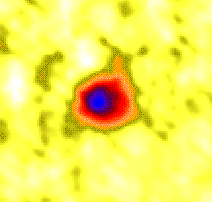|
|||||||||||||||||||
|
|
|||||||||||||||||||
|
|
Deep Survey Dead Spot MEMO
The Deep Survey Dead Spot is a region of lowered sensitivity (ie localized gain decrease) caused by a very high flux density of the bright EUV source, HZ 43. The January, 1993 observation on boresight focused light onto a very few microchannels. The resulting deadspot is a region roughly 800 microns (1.7 arcmin FWHM) in diameter with a very low response.
Deep Survey count rates are attenuated by up to 75% by the DS Dead Spot. A sensitivity map of the DS detector is constructed from Moon observations and is used for count rate corrections. Under certain conditions, countrates are restored to +/- 15% of their expected value.
The Memo included below describes the dead spot and a corrective algorithm.
Note from DC: I don't think people have had much luck in correcting Deep Survey images/light curves. The pixel-to-pixel variations are too great. The EUVE reference package includes a pixel Mask for the Dead Survey Lexan region (ds_dead.pl), but using this mask also throws away many good photons.
In 1997 EUVE lowered the lower-level discrimantor for the DS, which means that events from the region of low gain could be recovered using pulse-height filtering. However, this is only true in WSZ telemetry mode (which was used infrequently back in 93/94).
|
|
|




 Follow Us
Follow Us
 Sensitivity Map
Sensitivity Map